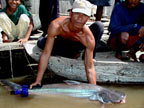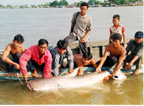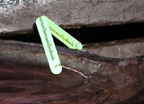|
Message to Thai Fishermen: Large Catfish Headed Your Way?
A catfish first tagged and released in the Tonle Sap River, Cambodia on November 30, 2001 has been recaptured 300 kilometers up the Mekong River (photo 1). The catfish, commonly called Pla Buek in Thai, regularly attains a size of 20 kg and over a meter in length in Cambodia. The fish, a close relative of the Mekong giant catfish (photo 2), was recaptured by a fisherman in northeastern Cambodia on February 8, 2001. The fish, which apparently moved out of the Great Lake at the end of the rainy season, was probably undergoing a spawning migration. Many species of Mekong fish, including the river catfish and the Mekong giant catfish, are believed to migrate out of the Great Lake and up the Mekong River to spawn.
The migration, the first of its kind documented in the Mekong River, is believed to be critical for the persistence of fish populations throughout the Mekong River Basin. Adult catfish appear to move into deep water areas of the Mekong River to survive the dry season, then migrate upstream and spawn with the onset of the first heavy rains in May and June. Young fish then float downstream with the rising water, eventually finding their way into inundated areas during the rainy season. Inundated areas, such as the flooded forest of the Great Lake, may act as rainy season nurseries for young fish of several species, including the Mekong giant catfish.
In order to better understand this process, fisheries biologists (Zeb Hogan, University of California, Davis, U.S.A. and Heng Kong, Freshwater Capture Fisheries Project) tagged and released 13 river catfish and Mekong giant catfish late last year as part of an ongoing conservation and research program. The program, called the Giant Catfish Conservation and Research Project and supported by the Zoological Society for the Conservation of Species and Populations, WWF-US, and the Cambodian Department of Fisheries, purchases threatened species from fishermen, tags the fish, and then releases them alive back into the river. The project is designed to keep threatened species off the dinner plate as well as learn about the migratory patterns of each species.
Researchers tagged the fish with ultrasonic transmitters that allow the fish to be detected using a specialized receiver and an underwater antenna called a hydrophone. Each fish was also tagged with a plastic marker that stated simply Please return to the Department of Fisheries (photo 3). It was this plastic marker that allowed researchers to relocate the tagged fish. When a Kratie man (photo #4) hooked the catfish on February 8, he noticed the tag and promptly contacted the Department of Fisheries. With the cooperation of fishermen and the Department of Fisheries, researchers hope to be able to follow the tagged fish to locate the probable spawning grounds of each species. Once spawning grounds are located, it is possible that these areas could be protected to help bolster declining fisheries.
Moreover, some scientists believe that Mekong giant catfish and other species may migrate from Cambodia to Laos and Thailand. Thus, another objective of our study was to determine the migratory pathways of the giant catfish and the river catfish. Information about the migratory patterns is needed in order to determine whether or not these fish migrate across international borders. If fish do move across borders, then fishing and development activities in Thailand and Laos likely impact fish populations in Cambodia and vice versa. This demonstrates the need for cooperative management of transboundary resources such as fish, especially in the case of an endangered species like the giant catfish.
For example, a giant catfish was caught in the Mun River, Thailand this year for the first time since the construction of Pak Mun Dam. The Pak Mun Dam may be impacting fish populations and fish migrations in Thailand as well as in neighboring countries. But in order to document these impacts, it is necessary to document the ecology and long distance migration of these fish species. It is possible that river catfish and giant catfish migrate from Cambodia to the Mun River in Thailand, and therefore one of the tagged giant catfish may be captured in the Mun River or elsewhere in Thailand during 2002. For this reason, we ask all fishermen along the Mekong River to watch for tagged giant catfish. Should a fisherman catch a tagged fish, please remove the tag, return the fish to the river, and contact the Thai Department of Fisheries. By returning the fish to the river, the lucky creature has a chance to continue its migration.
For more information:
Zeb Hogan
Wildlife, Fish, and Conservation Biology
University of California, Davis
zshogan@ucdavis.edu
|



|

